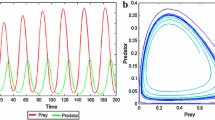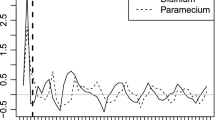Abstract
A new approach is proposed for building a model of the prey population in the “predator–prey” system without using data on the dynamics of the predator numbers. To replace these data, autoregressive models with a set of linear positive and negative feedbacks are considered, which replace data on the influence of predator populations. The proposed approach can be used to model local populations of animals, for which there are no complete data on their interactions with other species in the ecosystem. We used conjugate series of dynamics of prey and predator populations: “classical” data on the number of lynx and hare skins purchased by the Hudson’s Bay Company, as well as annual data on the number of moose and wolves on the Isle Royale on Lake Superior in North America. The studied populations were considered as auto-regulated (AR) systems with feedback. The regulation of the number of the prey populations (hares and moose) is characterized by the presence of two feedback loops: a positive feedback between the current population density and the population density in the previous season, and a negative feedback between the current population density and the population density 2 years before this. It is shown that in order to build a model of prey populations, there is no need to know how many species of predators (including humans) affect this population. Based on the data on the temporal dynamics of the studied populations, an assessment of the feedback coefficients of AR equations, their stability and stability margin is given. The coefficient of determination R2 for the considered models reaches the value R2 = 0.978.








Similar content being viewed by others
REFERENCES
Anderson, T.W., The Statistical Analysis of Time Series, New York: John Wiley & Sons, 1971.
Bazykin, A.D., Matematicheskaya biofizika vzaimodeistvuyushchikh populyatsii (Mathematical Biophysics of Interacting Populations), Moscow: Nauka, 1985.
Bazykin, A.D., Nelineinaya dinamika vzaimodeistvuyushchikh populyatsii (Nonlinear Dynamics of Interacting Populations), Moscow: Inst. Komp. Tekhnol., 2003.
Baltensweiler W., Fischlin A., The larch budmoth in the Alps, Dynamics of Forest Insect Populations. Boston: Springer. 1988, pp. 331–352.
Benton, T.G., Ranta, E., Kaitala, V., and Beckerman, A.P., Maternal effects and the stability of population dynamics in noisy environments, J. Anim. Ecol., 2001, vol. 70, pp. 590–599.
Berryman, A.A., Population Systems: A General Introduction, New-York: Plenum Press, 1981.
Berryman, A.A., On principles, laws and theory in population ecology, Oikos, 2003, vol. 103, no. 3, pp. 695–701.
Bjornstad, O.N., Fromentin, J.M., Stenseth, N.C., and Gjosaeter, J., Cycles and trends in cod populations, Proc. Natl. Acad. Sci. U.S.A., 1999, vol. 96, pp. 5066–5071.
Britton, N.F., Essential Mathematical Biology, London: Springer, 2003.
Bulmer, M.G., A statistical analysis of the 10-year cycle in Canada, J. Anim. Ecol., 1974, vol. 43, pp. 701–718.
D’eri, I. and Pertsev, N.V., On the stability of equilibrium states of functional-differential equations of retarded type possessing a mixed monotone property, DAN SSSR, 1987, vol. 297, no. 1, pp. 23–25.
Deng, B., An inverse problem: Trappers drove hares to eat lynx, Acta Biotheor., 2018. vol. 66, pp. 213–242.
Dorf, R.C. and Bishop R.H., Modern Control Systems, Menlo Park, CA: Pearson (Addison-Wesley), 1998, 8th ed.
Elton, C. and Nicholson, M., The ten-year cycle in numbers of the lynx in Canada, J. Anim. Ecol., 1942, vol. 11, pp. 215–244.
Fromentin, J.M., Myers, R.A., Bjornstad, O.N., Stenseth, N., Gjosaeter, J., and Christie, H., Effects of density-dependence and stochastic processes on the regulation of cod populations, Ecology, 2001. vol. 82, no. 2, pp. 567–579.
Gaiduk, A.R., Belyaev, V.E., and P’yavchenko, T.A., Teoriya avtomaticheskogo upravleniya v primerakh i zadachakh (Theory of Automatic Control in Examples and Tasks), St. Petersburg: Lan’, 2011.
Gause, G.F., The Struggle for Existence, Baltimore: Williams and Wilkins, 1934.
Gilpin, M.E., Do hares eat lynx?, Am. Nat., 1973, vol. 107, no. 957, pp. 727–730.
Gomatam, J., A new model for interacting populations two species systems, Bull. Math. Biol., 1974, vol. 36, pp. 347–353.
Gonzales-Andujar, J.L. and Hughes, G., Complex dynamics in weed populations, Funct. Ecol., 2000, vol. 14, pp. 524–526.
Hamming, R.W., Digital Filters, New Jersey: Prentice-Hall, Inc., Englewood Cliffs, 1977.
Hedrick, P., Robinson, J., Peterson, R.O., and Vucetich, J.A., Genetics and extinction and the example of isle royale wolves, Anim. Conserv., 2019, vol. 22, no. 3, pp. 302–309.
Hewitt, C.G., The Conservation of the Wild Life of Canada, New-York: Charles Scribner’s Sons, 1921.
Hoy, S.R., Vucetich, J.A., Liu, R., De Angelis, D.L., Peterson, R.O., et al., Negative frequency-dependent foraging behavior in a generalist herbivore (Alces alces) and its stabilizing influence on food-web dynamics, J. Anim. Ecol., 2019. vol. 88, pp. 1291–1304.
Hutchinson, G.E., Theory of competition between two social species, Ecology, 1947, vol. 28, pp. 319–321.
Il’ichev, V.G., Ustoichivost’, adaptatsiya i upravlenie v ekologicheskikh sistemakh (Resilience, Adaptation and Management in Ecological Systems), Moscow: Fizmatlit, 2009.
Isaev, A.S., Soukhovolsky, V.G., Tarasova, O.V., Palnikova, E.N., and Kovalev, A.V., Forest Insect Population Dynamics, Outbreaks and Global Warming Effects, New-York: Wiley, 2017.
Isaev, A.S. and Khlebopros, R.G., The principle of stability in the population dynamics of forest insects, DAN SSSR, 1973, vol. 208, no. 1, pp. 225–228.
Isaev, A.S., Khlebopros, R.G., Nedorezov, L.V., Kondakov, Yu.P., Kiselev, V.V., and Sukhovol’skii, V.G., Populyatsionnaya dinamika lesnykh nasekomykh (Population Dynamics of Forest Insects), Moscow: Nauka, 2001.
Isaev, A.S., Pal’nikova, E.N., Sukhovol’skii, V.G., and Tarasova, O.V., Dinamika chislennosti lesnykh nasekomykh-fillofagov: modeli i prognozy (Population Dynamics of Forest Phyllophagous Insects: Models and Forecasts), Moscow: KMK, 2015.
Jenkins, G.M. and Watts, D.G., Spectral Analysis and Its Applications, San Francisco: Holden-Day, 1969, 1st ed.
Keith, L.B., Wildlife’s Ten-Year Cycle, Madison: Univ. Wisconsin Press, 1963.
Kim, D.P., Teoriya avtomaticheskogo upravleniya (Theory of Automatic Control), Moscow: Fizmatlit, 2007, vol. 1.
Kolesov, Yu.S., Some tasks of mathematical ecology, in Differentsial’nye uravneniya i ikh primenenie. № 29 (Differential Equations and Their Application. No. 26), Vilnyus: Mokslas, 1981, pp. 27–35.
Kondakov, Yu.P., Patterns of mass reproduction of the Siberian silkworm, in Ekologiya populyatsii lesnykh zhivotnykh Sibiri (Ecology of Populations of Forest Animals in Siberia), Novosibirsk: Nauka, 1974, pp. 206–265.
Leigh, G., The ecological role of Volterra’s equations, in Some of Mathematical Problems of Biology, Providence: American Mathematical Society, 1968, pp. 1–61.
Lotka, A.J., Elements of Physical Biology, Baltimore: Williams and Wilkins, 1925.
Murray, J.D., Lectures on Nonlinear-Differential-Equation. Models in Biology, Oxford: Clarendon Press, 1977.
Montgomery, R.A., Vucetich, J.A., Roloff, G.J., Bump, J.K., and Peterson, R.O., Where wolves kill moose: The influence of prey life history dynamics on the landscape ecology of predation, PLoS One, 2014, vol. 9, no. 3. https://doi.org/10.1371/journal.pone.0091414
Nedorezov, L.V. and Utyupin, Yu.V., Nepreryvno-diskretnye modeli dinamiki chislennosti populyatsii: analiticheskii obzor (Discrete-Continuous Models of Population Dynamics: Analytical Review), Novosibirsk: Gos. Publichnaya Nauch.-Tekhnich. Biblioteka Sib. Otd. Ross. Akad. Nauk, 2011.
O’Donoghue, M., Boutin, S., Krebs, C.J., Zuleta, G., Murray, D.L., and Hofer, E.J., Functional responses of coyotes and lynx to the snowshoe hare cycle, Ecology, 1998. vol. 79, pp. 1193–1208.
Odum, E.P. and Barrett, G.W., Fundamentals of Ecology, Philadelphia: Saunders, 1971.
Pertsev, N.V., On one generalization of the logistic model of the dynamics of populations with a limited lifetime of individuals, Vestn. Omsk. Gos. Univ., 1997, no. 1, pp. 14–16.
Pertsev, N.V., Pichugina, A.N., and Pichugin, B.Yu., Behavior of solutions to the dissipative integral Lotka–Volterra model, Sibirskii Zhurnal Industrial’noi Matematiki, 2003, vol. 6, no. 2 (14), pp. 95–106.
Peterson, R.O. and Page, R.E., The rise and fall of Isle Royale wolves, 1975–1986, J. Mammal., 1988, vol. 69, pp. 89–99.
Peterson, R.O., Thomas, N.J., Thurber, J.M., Vucetich, J.A., and Waite, T.A., Population limitation and the wolves of Isle Royale, J. Mammal., 1998, vol. 79, no. 3, pp. 828–841.
Pollard, J.H., A Handbook of Numerical and Statistical Techniques, Cambridge Univ. Press, 1979.
Rohner, C., The numerical response of great horned owls to the snowshoe hare cycle: consequences of non-territorial ‘floaters’ on demography, J. Anim. Ecol., 1996. vol. 65, pp. 359–370.
Royama, T., Analytical Population Dynamics, London: Chapman and Hall, 1992.
Soukhovolsky, V., Kovalev, A., Tarasova, O., Modlinger, R., Křenová, Z., et al., Wind damage and temperature effect on tree mortality caused by Ips typographus L.: Phase transition model, Forests, 2022, vol. 13. https://doi.org/10.3390/f13020180
Soukhovolsky, V.G., Tarasova, O.V., and Kovalev, A.V., Modeling critical events in forest insect populations, Zh. Obshch. Biol., 2020, vol. 81, no. 5, pp. 374–386.
Stenseth, N.C., Falck, W., Bjornstad, O.N., and Krebs, C.J., Population regulation in snowshoe hare and Canadian lynx: Asymmetric food web configurations between hare and lynx, Proc. Natl. Acad. Sci. U.S.A., 1997, vol. 94, pp. 5147–5152.
Svirezhev, Yu.M. and Logofet, D.O., Ustoichivost’ biologicheskikh system (Sustainability of Biological Systems), Moscow: Nauka, 1978.
Turchin, P., Complex Population Dynamics: A Theoretical/Empirical Synthesis, Princeton: Princeton Univ. Press, 2003.
Volterra, V., Fluctuations in the abundance of a species considered mathematically, Nature, 1926, vol. 188, pp. 558–560.
Volterra, V., Matematicheskaya teoriya bor’by za sushchestvovanie (Mathematical Theory of the Struggle for Existence), Moscow: Nauka, 1976.
Vucetich, J.A., Hebblewhite, M., Smith, D.W., and Peterson, R.O., Predicting prey population dynamics from kill rate, predation rate and predator-prey ratios in three wolf- ungulate systems, J. Anim. Ecol., 2011, vol. 80, pp. 1236–1245.
Wei, W.W.S., Time Series Analysis, Boston: Addison Wesley, 2006.
Yurchenko, G.I. and Turova, G.I., Sibirskii i belopolosyi shelkopryady na Dal’nem Vostoke (Siberian and White-Striped Silkworms in the Far East), Khabarovsk: Feder. Gos. Uchrezhdenie Dal’nevostochnyi Nauchno-Issled. Inst. Lesnogo Khozyaystva, 2007.
Zhang, Z.B., Tao, Y., and Li, Z.Q., Factors affecting hare-lynx dynamics in the classic time series of the Hudson Bay company, Canada, Clim. Res., 2007, vol. 34, pp. 83–89.
Funding
The work was supported by the Russian Science Foundation, grant no. 22-24-00148.
Author information
Authors and Affiliations
Corresponding author
Ethics declarations
COMPLIANCE WITH ETHICAL STANDARDS
This article does not contain any research using animals as a subject.
CONFLICT OF INTEREST
The authors declare that they have no conflicts of interest.
Rights and permissions
About this article
Cite this article
Soukhovolsky, V.G., Ivanova, Y.D. & Kovalev, A.V. Are Data on Predators Necessary When Modeling Prey Population Dynamics?. Biol Bull Rev 13, 216–227 (2023). https://doi.org/10.1134/S207908642303009X
Received:
Revised:
Accepted:
Published:
Issue Date:
DOI: https://doi.org/10.1134/S207908642303009X




